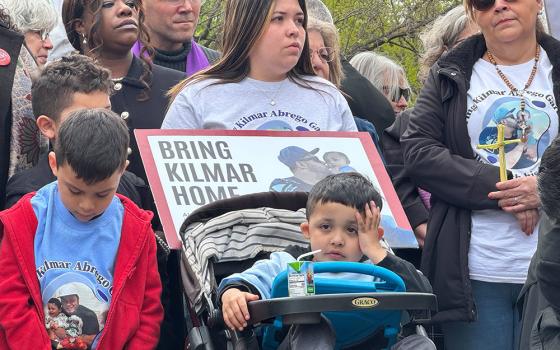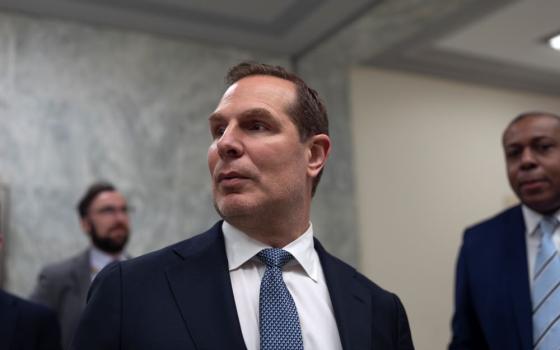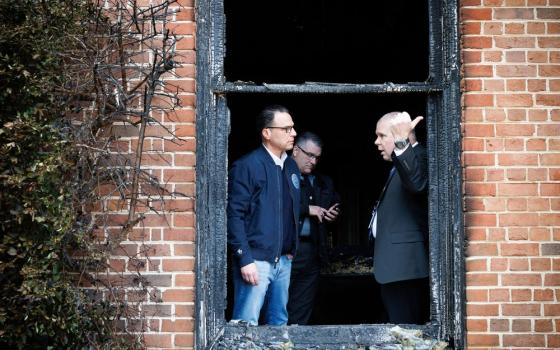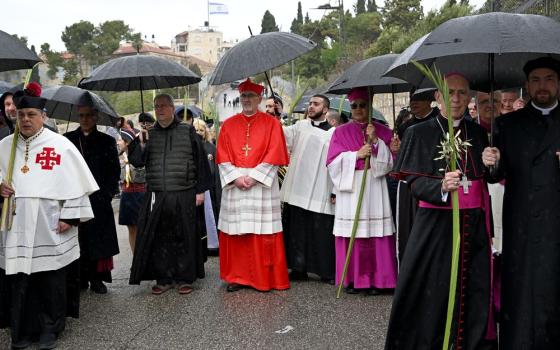
A LCVP (Landing Craft, Vehicle, Personnel) from the U.S. Coast Guard-manned USS Samuel Chase disembarks troops of the U.S. Army's First Division on the morning of June 6, 1944, at Omaha Beach, France. (Wikimedia Commons/Chief Photographer's Mate (CPHOM) Robert F. Sargent, U.S. Coast Guard)
If you're up at 6:30 a.m. Friday -- the 70th anniversary of the D-Day landing -- exhale and take a deep breath of gratitude. Be glad that you're reading this story in English and there aren't 930 years remaining of the Nazis' longed-for -- and hard-fought-for -- Thousand-Year Reich.
Take some time to recall the thousands of soldiers who bolted out of their landing crafts into a hail of mortar and cannon fire as they struggled on the fortified beaches of Normandy, France. Rushing to the presumed safety of the Atlantic bluffs, which the soldiers tried to scale, some were blown up on the waterfront or drowned in the channel where a few of their ships were sunk.
It all started at 6:30 a.m. at Omaha beach, a few miles to the east of Utah, and continued -- almost like clockwork throughout the day -- on three beaches east of Omaha: Gold, Juno and Sword. By nightfall on June 6, 1944, the 50-mile stretch of coastline saw 156,000 men and 20,000 vehicles dock.
Standing on this sacred terrain a few weeks ago with its giant memorials to the sailors, engineers, airmen, minesweepers, rangers and soldiers who fought and died here, I could only imagine the cacophony of the arriving vessels, the exchange of exploding shells, the yelps of anguish as comrades fell. Gazing out at one of the many German fortifications that lined the beach, I could envision the dumbfounded look of Nazi gunners at their batteries when they saw by dawn's early light not seagulls, but a tsunami of ships, all presumably carrying Allied attackers and their fighting gear.
Back in London, the logisticians plotting this world-changing enterprise knew they would need one ton of supplies per man per month. Their plan was to send 3 million men through Normandy to turn the tide of tyranny that was trampling Europe. Never in human history had such an armada been organized, let alone executed. Besides armaments, rations, uniforms, blankets, boots, tents and medical supplies, the troops needed tanks, trucks, bulldozers, bikes, cranes, hospital cots, planes, locomotives, prison cages, morgues, kitchens, fuel, radar, radios and repair facilities.
The list of things to take to the continent stretched to 7,000 items and included silk stockings, chocolates, Lucky Strike cigarettes and, most prized of all, antibiotics, which meant many combatants could survive their wounds.
How could the Allies manufacture and transport virtual stores of supplies to the front to outfit such an enterprise, fittingly named "Operation Overlord"? They needed to build and deploy a portable harbor, the Mulberry, which they used daily until after the liberation of the port of Cherbourg on July 16.
"The first 24 hours of the invasion will be critical ... the future of Germany will depend on the outcome ... for the Allies as well as for Germany it will be the longest day," said German Field Marshal Erwin Rommel during an earlier inspection of the Atlantic Wall the Germans were building -- though not fast enough -- to keep the Allies out.
Rommel was Hitler's tactical chief in the West now that his campaigns in North Africa and Italy had ended. Four months after D-Day, the Führer would accuse him of high treason. Rommel chose to swallow the cyanide pill rather than stand trial. Hitler sent a 6-foot floral wreath even before confirming his field marshal died of injuries sustained earlier while riding in his open car in Normandy.
Christendom's fate
"Upon this battle depends the survival of Christian civilization," British Prime Minister Winston Churchill said in the run-up to the invasion. England had endured four years of deprivation because of German occupation of Egypt and the submarine warfare that vexed vital shipping lanes. He was only too glad to have U.S. President Franklin Roosevelt and his Yanks leading the charge against the enemy under Supreme Allied Commander General Dwight "Ike" Eisenhower.
Prior to visiting the beaches and cemeteries of the Normandy invasion in April, I tended to link "the longest day" with the 1962 blockbuster film of the same name. But the Normandy landing was about more than American liberating forces. It was about united resolve and unwieldy cooperation among U.S., British and Canadian soldiers, sailors and aviators aided by Belgian, Czech, Danish, Dutch, Norwegian, Polish, South African, Australian and New Zealander support staff and those from the French Resistance. Their flags decorate these beaches today.
Flags of the Allied nations also fly at the World War II Museum in New Orleans, a city that had a huge contribution to the war effort. While he may not be a household name outside the Big Easy, Andrew Higgins is "the man who won the war for us," Eisenhower said. Higgins converted seven of his New Orleans factories into assembly-line manufacturing hubs turning out 700 Higgins boats a month by 1944.
The boat-builder produced a craft with a hinged prow that could run onto a beach, unload its men and cargo, and back out into the deep. Over 90 percent of the 14,072 landing craft used in the invasion were Higgins boats. One hangs in the lobby of the New Orleans museum. I had to go see for myself.
"Did you see my brother's photo in the museum?" asked my friend Pat Gorenc when we met last month in Milwaukee, where she lives.
"I must have," I told her, having spent a day and half in the museum earlier this year, fascinated with every exhibit. "Was his name on it?" I asked. She indicated there was a giant photo of Eisenhower talking to her brother and other paratroopers of the 101st Airborne Division before they flew to Normandy. In a back room, her brother, Joe Gorenc, is identified in a second photo.
When I returned home, I quickly found Joe's picture in Ken Ford and Steven Zaloga's book Overlord: The D-Day Landings. In the photo, he's climbing aboard a C-47 on the evening of June 5, 1944. Like his fellow 16,000 U.S. and 8,000 British paratroopers, each jumper carried about 200 pounds of weapons and gear on him. Their kit also included a child's cricket clicker, a vital device for locating one another in the dark. Joe knew that the password for safety that night was the simple call "thunder" and response "lightning."
Eisenhower reportedly said it is hard to look a man in the eye the night before you send him on a mission he may not survive. I will return to New Orleans one day to check if the general is looking Joe in the eye. Eisenhower warned that casualty figures could reach 75 percent for paratroopers, the majority of them landing in darkness, many of them blown off course, others caught in trees, swamps or impaled on a church steeple. The final tally was a 10 percent casualty rate among all paratroopers.
Joe, who left Marquette University to enlist, made it out of France alive, even after having been a prisoner of war and MIA. How long he was missing in action is unknown, said his sister, who was an infant at the time.
I reckoned he would be in his 90s now. "Had he died?" I asked. Pat related how Joe had returned to his home town of Sheboygan, Wis., married, had two daughters and in his early 30s was an officer in a new startup manufacturing firm. While he, the owner and another man were working late in the shop, an oil tank exploded. The young man died; Joe and the owner were injured, Pat said.
"The story I was told was when the tank exploded and the hot oil hit my brother, he did what he was trained to do as a paratrooper when you hit the ground -- he rolled to lessen the shock of impact. Joe sustained life-threatening injuries and died two weeks later, said his sister, who was 14 at the time.
Pat and I have known each other over 40 years, yet I have never heard this story -- proof no doubt that women who become friends as college freshmen probably don't ask whether they've had any siblings who took part in the D-Day landing.
That one of the 24,000 paratroopers is now known to me makes the valor of these men even more vivid. Their sacrifice is memorialized in the Normandy American cemetery at Colleville-sur-Mer, overlooking Omaha Beach, where 9,387 American graves -- four of them of nurses -- lie. Their heroism is also evident at the graves of 4,410 servicemen at the Brittany American Cemetery in Saint James, France. As I see the names of the more than 2,000 Americans missing in the Battle of Normandy, I consider the families of those whose loved ones recently disappeared aboard the Malaysian Airlines plane and on the South Korean ferry.
In the German cemetery at La Cambe, France, I viewed the grave of Anton Schulz, 17, and Jakob Hollecker, 22, two soldiers buried under a joint marker -- like the majority of the 21,400 in this somber field. Overall, 80,000 German combatants are buried in German, French and British cemeteries in France -- only one of dozens of nations at war with Germany. Cause of death of both Nazi and Allied warriors: following orders.
For years, I've thought of Operation Overlord as synonymous with breath-taking action and organization, with months of maneuvers and the movement of men and machinery. Now that I've seen the killing fields and the burial plots of Normandy, I wonder if "Overlord" might not be code for the Higher Power who ordains all operations and whose ways are often an enigma yet to be decrypted.
British Admiral Bertram Ramsay, who headed Normandy's naval operations, penned in his diary that he was "under no delusion as to the risks involved ... We shall require all the help that God can give us and I cannot believe that this will not be forthcoming."
If you're up at 6:30 a.m. on D-Day, raise a thought of gratitude for these men and their Overlord, who continues to liberate us all.
[Patricia Lefevere is a longtime NCR contributor.]




